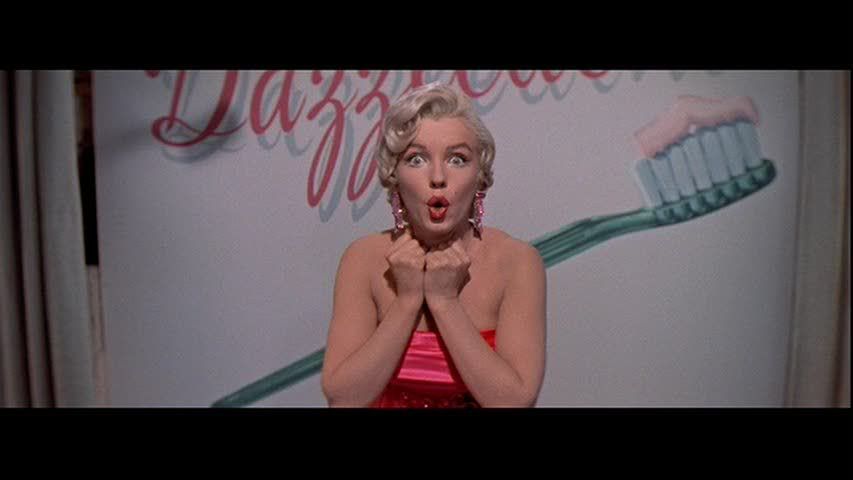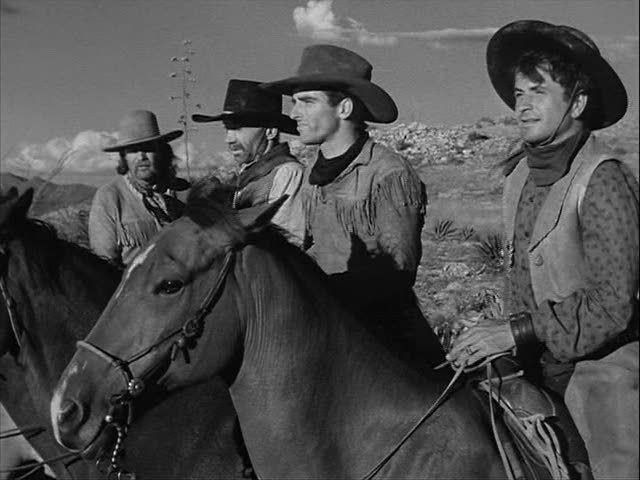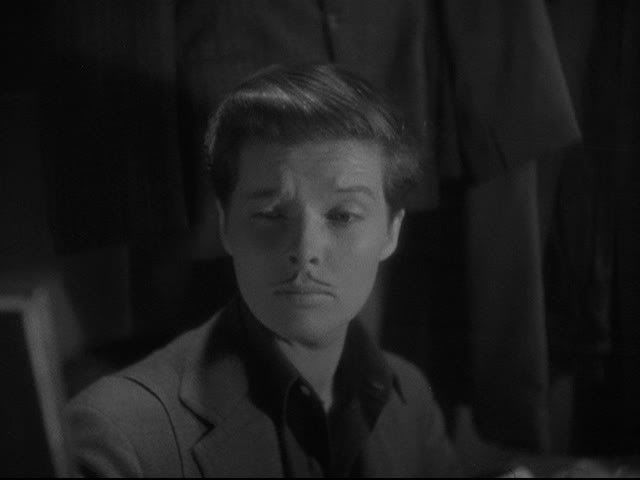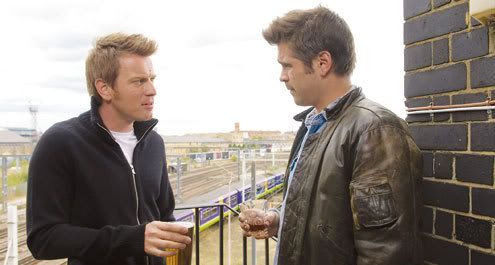
The first scene of
Kill, Baby... Kill! is as powerful, visceral, and over-the-top as its title might suggest. The film opens abruptly, as though in the middle of a scene, with a woman running away from a large castle, screaming "No! No!" She runs towards the camera, which alternates between askew closeups that emphasize the terror in her eyes, and long shots that situate her fleeing form in the gloomy darkness of the castle's front lawn. The woman runs into a nearby building, then stops as though transfixed in horror by the sight of a spiked grating below her — which she soon enough leaps to her death by impaling herself on it. It's a harrowing, mesmerizing, intriguing scene, one that promises a great psychological horror film in the making.
In the course of this moody 1966
giallo, director Mario Bava rarely again achieves the same visceral impact as those opening minutes, though what the film lacks in chills it makes up for in atmosphere and the dazzling, garish cinematography. The story of Bava's film is a classic ghost yarn, of a young girl who was killed and has since haunted and cursed the residents of the town in which she died. A doctor (Giacomo Rossi-Stuart) and an inspector (Pierro Lulli) arrive in the town to investigate this latest murder, to which they were alerted by the note the unfortunate woman wrote before her death. The story, obviously, is the stuff of countless other horror films, and frankly many of those others handled the scares much better. Bava, on the other hand, hardly seems to be interested in frightening his audiences so much as impressing them with the lurid quality of his visuals. The flashy camerawork is constantly calling attention to itself, with rapid zooms and pans disrupting the fluid flow of the cinematography. When the local constable (Luciano Catenacci) is first introduced, Bava brings him in with an exceedingly fast zoom onto his sinister, bald-headed countenance, accompanied by a dramatic theme on the soundtrack. The sudden emphasis suggests that this man will be tremendously important to the plot, maybe even the villain himself; the fact that he barely appears after this scene is not nearly as important as Bava's willingness to make anything and everything a matter of such visual sturm-und-drang.
In a later scene at the local cemetery, Bava again plays with such conventions of camerawork and emphasis, with a bizarre swinging zoom that focuses in, then swoops back out again, on a faraway tree stump chosen seemingly at random. Is the stump important? Or is the camera itself important, indicating the movement of something that could explain the creaking noise heard on the soundtrack? It turns out to be neither — in fact, Bava is just using this unmotivated camera movement as a distraction, and after several zooms in and out, the legs of a girl hanging down from above suddenly swing across the frame at a perpendicular angle to the movement of the camera. Once again, this moment isn't even remotely explained or returned to later, and the presumed corpse is never discovered, but it's a striking and memorable shot anyway. Bava routinely disregards the machinations of his silly plot in favor of such visual grandeur, which is inscribed into every frame of the film. The camera is constantly darting around to ascribe overblown importance to random bits of mise en scéne, like the portrait of the dead girl that Bava zooms in on, then further draws attention to the plaque underneath that lists her lifespan as 1880-1887, a fact that might've had more impact if Bava ever bothered to establish the year in which his film takes place. It doesn't really matter though, since we get that he's just making the conventional gesture towards the "spooky" fact that the little blonde girl who we've seen wandering around the screen singing eerie songs is in fact a ghost, as if we couldn't have guessed.
It's hard to take too seriously a film that puts so little stock in its own premise, but Bava clearly takes such pleasure in the lurid colors and composition of each frame that
Kill, Baby... Kill! winds up being a lot of fun anyway. With its striking aesthetics and some great kitschy performances, especially from Fabienne Dali as the local witch who tries to fight the curse, this is a classic of gothic horror in spite of its silliness and lack of scares.
His Girl Friday is a perfect screwball farce from Howard Hawks, built on a model of steadily escalating insanity, with Cary Grant orchestrating the entire maelstrom as the quick-witted and scheming newspaperman Walter Burns. This is a typically great comic performance from the always reliable Grant, who handled the fast-paced dialogue of a Hawks screwball like no other actor. Here he's playing opposite the similarly sharp Rosalind Russell as his ex-wife, the former reporter Hildy Johnson, who has returned to his life only to politely inform her ex that she's remarrying, to the slightly dopey but sincere insurance salesman Bruce Baldwin (Ralph Bellamy). Obviously, Grant isn't going to stand for this, and he immediately begins concocting as many schemes as he can think of to prevent Russell and her new fiance from leaving on the afternoon train.
The film crackles with the strength of the Grant/Russell pairing, and their verbal sparring is unfailingly hilarious, as well as indicative of the underlying dynamics of their relationship and failed marriage. They originally split up because Russell was discontented with their unstable life, with the lack of any traditional lifestyle or comforts — their honeymoon was spent covering a coal mine story instead of anything more romantic. Her new husband is thus much more stable, as well as more romantic and conventional. While he tells her that "even ten minutes without you feels too long," Grant consistently disregards all propriety and even forgets to hold doors for her, letting them slam in her face behind him. Bellamy knows how to treat a lady, while Grant does not. But the script's central question is whether Russell is actually a "lady" at all, and as usual in Hawks' films, the answer is an emphatic (and ecstatic) "no." The film posits a dichotomy between the ladylike option of being a housewife, having children, and settling down, and the more vigorous and non-traditional option of continuing to have a career, working in the company of men as part of their fast-paced world. Clearly, Russell belongs in this world, and Grant's manipulations mostly center around his attempts to bring her back into the world of journalism, if only for one story, knowing that once she's gotten the taste for it again, she'll be back for good. Indeed, it's not too long before Russell is stationed at a press room phone, barking out stories and hot tips, and it's obvious that this is where she belongs, comfortable in a man's world and not playing wife to anyone, even if sometimes that's what she thinks she wants.
These sexual politics may drive the plot and its underlying themes, but it's the film's glistening comedic surfaces that really propel it forward and keep the viewer utterly rapt. In addition to the central Grant/Russell rapport, each of them gets to try their quick wits and verbal dexterity against a seemingly never-ending variety of straight men. If Grant and Russell are roaring through life at triple speed, everyone else in the picture seems to be coasting along in a lower gear, and the script takes great joy in the way this comedic duo tears into everyone around them. The dim-witted city sheriff Peter B. Hartwell (Gene Lockhart) gets a lot of this abuse, especially concerning his middle initial — "the B is for brains," Russell quips, after recounting how the sheriff allowed a murderer to escape by handing him a gun so a psychologist could watch him re-enact his crime. All the other cops and reporters on hand also get their time as the butt of these jokes, as does Bellamy as the luckless would-be hubbie who keeps winding up in jail due to Grant's hijincks. But best of all is Billy Gilbert in a hilarious cameo as a ludicrously dumb state lackey delivering an important message — his quick tongue and flawless timing are put to brilliant use as he stammers his way through a number of conversations in which he clearly has no idea what's going on.
Hawks' characteristic overlapping dialogue, everywhere present throughout this film, is also used to especially great effect in the many scenes involving telephones. In many ways, this could be called a telephone comedy, although it is not, as this might imply, a film in which the characters often talk to each other over the phone. Rather, most of the phone scenes in the film involve many people in the same room, all yelling into different phones at different unseen and mostly unknown people on the other end. Hawks handles this kind of chaos very well, and there's a particularly noteworthy scene where a bunch of reporters are returning, in dribs and drabs, to send their latest updates back to their papers. Hawks simply sets up at the end of the press room table and waits for the reporters to return, which they soon do, forming a sort of musical round of voices as they each step into the frame. One comes in, begins his report over one phone, then another fills in the space to his left and begins a different report, then another just as the first one is leaving. This babble of voices, telling different, often wildly contradictory, versions of the same story, is a recurring theme in the film, and Hawks always makes sure to carefully situate these different voices within the frame as well. In a later scene, Grant is calling his paper from a phone in the right foreground, while to the left and behind him Russell attempts to conduct a conversation with the police to locate her arrested fiance and his mother. The competing voices of the soundtrack are thus reflected in the tension of the halved frame.
This is a flawless comedy, with Hawks leading his stellar cast through a typically fast-paced, non-stop barrage of witty wordplay and comic scenarios. The dialogue crackles with energy and verve, and the performers stand up to the task in every way. The classic screwball era may well have provided some of the best comedies of all time, and
His Girl Friday is one of the best of the best.
While Alfred Hitchcock is an acknowledged genius of the thriller and undeniably a giant of Hollywood film, his comedic talents are still viewed, unfortunately, as somewhat secondary. Not only were his thrillers frequently padded with subtle humor and sexual innuendo, but he also made the much-maligned but utterly charming
To Catch a Thief, and my personal favorite Hitchcock film,
The Trouble With Harry. This quirky, totally strange comedy takes a familiar thriller subject, the dead body found mysteriously in the woods, and disarms its menace by having the people who find it — a motley assortment of cheery New England rural folks — treat its sudden appearance in their lives as a small bother at worst, a minor distraction from what really is, after all, a rather pleasant day. That these gentle souls are so unperturbed by the corpse in their woods is the film's essential joke, a single gag that's stretched out with such droll wit and total commitment to these bizarre personalities, that the film becomes absolutely irresistible.
It all starts when Captain Wiles (Edmund Gwenn) stumbles across the body of Harry lying in the woods, and he believes that he accidentally shot him while rabbit hunting. He is mildly distressed about the possibility of going to jail, so he resolves to bury the corpse, but before he can, seemingly the whole town stumbles into the area. There's a kindly old maid (Mildred Natwick) who just politely asks him what's the trouble when she comes across him carrying the body by the legs, a bookish professor who nods and apologizes to the body when he trips over it, the lovely Jennifer (Shirley MacLaine), who seems outright overjoyed when she sees the dead body (because it's her husband, naturally), and the local artist Sam (John Forsythe), who decides to sketch the corpse. What ensures from this point is a subtly hilarious but outwardly deadpan farce, in which these people, for various reasons and motivations, keep burying and then digging up again the unfortunate Harry, who seems to be causing a great number of complications even after his death. This all takes place in the cheery sunlit setting of autumnal New England, which Hitch captures in a static but sumptuous visual style that makes each exterior shot look like a postcard — the film's rich orange and red hues serve as a perfect contrast to the gallows humor and casual disinterest in mortality that these characters evince.
Indeed, the film is a subtle satire of small-town life, as well as a certain provincial mentality that cares for little outside of oneself. Hitchcock both celebrates and mocks this mentality, but for the most part the film is a loving tribute to these people, who casually resist all authority — represented in the film by the bumbling local constable, who's paid by the arrest and thus makes every effort to find even the pettiest of offenses — and likewise strive to maintain their sheltered provincial existence from even good intrusions of the outside world. The struggling artist Sam is remarkably indifferent to monetary success. When he gets a chance to sell his paintings, he declares them priceless and instead of asking for money, requests that the buyer fulfill the wants of his friends: strawberries, a chemistry set, a new cash register, a shotgun and hunting outfit, a hope chest. This selfless act of kindness and bigheartedness belies the idea that these people are entirely self-centered and careless, and in this context their disregard for Harry's body takes on its proper significance.
It's a film in which death is merrily shrugged off so that life may go on for the living, and it's no coincidence that Hitchcock implicitly counterbalances death with sex. The burying of Harry becomes a mere pretext for the development of two new romantic relationships, and this burgeoning love is reflected in the film's depiction of sensual beauty in its many landscape shots. The film is also loaded with clever sexual innuendos, just barely disguised, and I will never cease to cackle with glee when Forsythe tells Gwenn: "don't you realize you'll be the first man to cross her... threshold?" Hitch was clearly having a lot of fun with this subtly naughty material, and all the actors seem to be in on the joke and having a ball as well. It's a riot, a gorgeous ode to rural autumns, and a celebration of the simple pleasures of a life in which death is just a minor mishap, easily forgotten with some tea and blueberry muffins.
Billy Wilder's
The Seven Year Itch has, seemingly, an airtight premise: take a dumpy middle-aged married man (Tom Ewell), send his wife and kids away for the summer, and put the stunningly gorgeous Marilyn Monroe upstairs from him as a constant source of temptation. The results should be both hilarious and sizzling, by all rights, and they are, at least whenever Monroe herself is onscreen. But for too much of the film, she's not, and large portions of the film focus solely on Ewell, whose paranoid fantasies, neuroses, and wild flights of imagination are mildly amusing at times, but more often just tedious and clunky. The film opens with an equally unamusing vignette with some Indians providing an old-time parallel to the main story, and a painfully unfunny narrator who thankfully disappears early in the film. Ewell spends much of the film by himself, talking incessantly despite the fact that no one else is around, and the film never adequately explains why this man feels the need to narrate every little thing he does, other than to keep some dialogue moving. It's also a mystery why, given Monroe's breathless and hilarious performance as the sweetly naïve and ditzy girl upstairs, and the surprisingly great chemistry between her and Ewell, the film keeps her offscreen for so long.
However, whenever she's around, the film sparkles and sizzles in exactly the way it should. Her introduction is a fabulous half-hour scene in which Ewell, tortured by guilt but nevertheless taking advantage of his wife's absence, invites her to his apartment for drinks. Monroe's character, unnamed and archetypically called just "The Girl," is indeed like an elemental force of nature that blows into Ewell's life with little regard for conventionality or ordinary social relations. Monroe's character is deliriously unmindful of her own sexuality, thinking nothing of appearing naked on her balcony or blithely announcing that she keeps her panties in the freezer during the summer. Her every move and utterance seems calculated to attract attention — as, indeed, the real Marilyn probably constructed her breathless, carefree persona — but her character is simply doing and saying whatever comes into her airy head. "Do you drink?" Ewell asks her at one point. "Oh yeah, like a fish," she burbles, but then is unable to come up with an acceptable drink and finally asks for a "big, tall" martini. Her character is pure Id, a wonderfully ludicrous male fantasy congealed on the screen in all her vivid reality. Ewell's character is given to wild daydreaming and fantasies, but he's incapable of dreaming up anything crazier than the real Marilyn as she appears here. In his imagination, she's pretty much just like she actually is in both his reality and the reality outside the picture, a reality that's acknowledged towards the end when Ewell yells out, "What blonde? Maybe it's Marilyn Monroe!"
This line is indicative of just how much the film is actually about the mystique of Marilyn, rather than about any character played by her. Marilyn's character here is sexual desire, abstracted and idealized — she's not a particular instance of the sex goddess but the Ur-goddess, the libidinal being on whom all others are based. In her raw simplicity and bubbly good humor, she's the spirit of pure, innocent sensuality and desire. As long as she's onscreen,
The Seven Year Itch is a comic gem, but in the long stretches when she's nowhere to be found, it's a dull and awkward bore where even the jokes fall flat. Maybe that's part of the point, though — Ewell's character is a boring slob, a nobody, animated and brought to life only in relation to the radiant brilliance of Monroe, who burns bright but too briefly in this film as in life.








